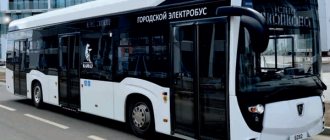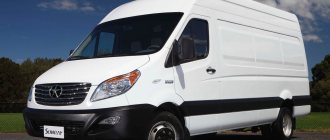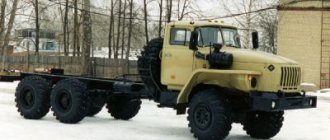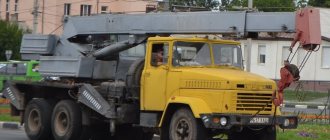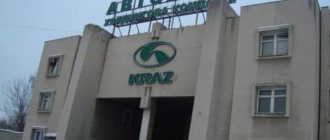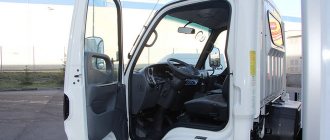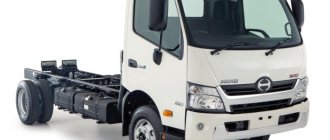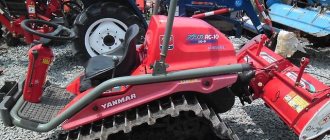City bus MAZ-206. Photo Wikipedia
The low-floor bus of this model is a reliable vehicle designed for passenger transportation. MAZ-206 can be operated on urban and suburban routes . The success of the sales model is provided by such advantages as:
- thoughtful cabin layout and modern equipment ensuring passenger comfort and safety;
- technologically advanced units and components combined with environmentally friendly materials, ensuring the MAZ-206 is economical and environmentally friendly.
History of creation
The Minsk Automobile Plant is the largest machine-building enterprise in the CIS, and the equipment it produces is very popular in many countries around the world. The branch, whose main activity was the production of passenger buses, appeared in 1992 and was named AMAZ. The need to open our own bus division was a forced step - the supply of Hungarian buses in the late 80s. years were reduced to a minimum, and the country's bus fleet required updating. Having signed a license agreement with the German bus company ]Neoplan[/anchor] for the production of buses of the same name under the symbol N4014, Minsk residents began work.
Interior of the MAZ-206 bus. Photo MAZ
After some time, the basic model was significantly improved, and AMAZ designers managed to adapt it to local operating conditions - so in 1996, the first low-floor bus of its own production, MAZ-103, appeared in the country.
Afterwards, several more models of passenger transport were created, most of which are successfully operated in Belarus, Ukraine and Russia.
10 years later, in 2006, at the motor show in Moscow, another new product was presented to the general public - the MAZ-206 low-floor city passenger bus.
The medium-capacity vehicle was designed to travel on lightly congested routes . The bus could also be used as a service passenger or VIP bus.
The first buses rolled off the assembly line already in the fourth quarter of 2006 , and in 2007 Belarusian fleets were already using the new product with might and main.
A year later, MAZ released a suburban modification of this model, which received the MAZ-226 index. Unlike the original version, this bus does not have a storage area - there are additional seats there. There is a space allocated for luggage compartment on the left side of the bus.
The MAZ-206 bus belongs to the second generation of passenger transport produced by AMAZ.
The MAZ-203 model, released a year earlier, was used as the basis for the creation of the MAZ-206. However, unlike its 12-meter predecessor, the new bus is shorter and has two doors. The overall dimensions of the vehicle are 8,650 x 2,550 x 2,930 mm. The total weight of the bus is 12,820 kg.
Manufacturer
The MAZ-206 bus is produced by the Minsk Automobile Plant, located in the capital of Belarus. The company is the largest manufacturer of equipment among all CIS countries. The plant's products are popular not only in their native Belarus, but also in Russia, as well as in the countries of Southeast Asia.
The company was founded immediately after the liberation of Minsk, in August 1944. The plant initially produced heavy-duty vehicles and trailers. The production of city buses began not so long ago, in 1992. The supply of buses from Hungary for city streets was stopped, so the country's passenger transport required updating. Soon it was decided to open a branch of the automobile plant in Minsk, which was named AMAZ.
The development of buses began with the signing of a contract with a bus manufacturer in Germany. Already in 1996, AMAZ specialists were able to present the first low-floor model produced in the country - it was the MAZ-103.
The development of the bus model range continued. And already in 2006, the MAZ-206 was presented in Moscow. This is a second generation model, which is assembled using imported components and parts. The basis for its production was the MAZ-203, which has a length of twelve meters.
Detailed description, interior design and more
Interior and body. As mentioned above, the MAZ 206 bus is a representative of the family of low-floor buses, which is its undeniable advantage.
Bus MAZ-206, left view. Photo Wikipedia
This design makes it possible to make boarding and disembarking passengers faster and more convenient , increase the average speed along the route and adapt transport to the needs of the elderly and people with musculoskeletal disorders.
The storage area , located in front of the second door, is designed to accommodate a wheelchair.
Equipment of the MAZ-206 in accordance with the needs of people with disabilities involves the installation of additional devices.
A wheelchair can enter or leave the salon using a special folding ramp.
In order to signal the driver about the need to unfold the ladder inside and outside the cabin, there are buttons, when pressed, a warning sensor lights up on the dashboard.
The interior layout is made according to a four-row layout . The total number of seats is 25, most of them are located in the rear of the bus.
The seats offered by MAZ are semi-soft, fabric upholstered, non-separable . The customer is given the opportunity to choose between chairs of local (OZAA) and Polish (Ster) production.
The number of passengers that the bus can accommodate according to the passport reaches 72 people.
The all-metal body of the 206th MAZ is load-bearing and belongs to the carriage type. are used to manufacture the body structure . The welded frame of the bus is sheathed with galvanized steel sheet - this is how the roof and side walls are formed.
The front and rear parts of the body, as well as removable bumpers, are made of fiberglass . The interior and engine compartment are finished with fire-resistant materials.
To paint buses, polyurethane paint is used, and the color can be any - the manufacturer focuses on the customer’s wishes.
To increase the rigidity of the body, glass is glued into the openings using a seamless method. For the manufacture of the windshield a three-layer material ; the side, rear and door windows are made of tempered heat-absorbing glass.
Rear part of the MAZ-206 interior. Photo MAZ
The interior is ventilated naturally : fresh air enters the bus through hatches located on the roof and windows. In addition, if desired, this public transport can contain an air conditioning system. A less expensive option is to install a ceiling ventilation system.
The heating is a three-circuit system. In order to heat the bus interior, the energy of the engine cooling liquid is used. The driver's workplace is heated by means of an additional heater, which has a pair of radiators and several fan drives.
MAZ-206 is equipped with two sliding doors through which passengers can board/disembark. The doors are made of aluminum profiles , have a large glass area, and are protected from loads by handrails installed diagonally.
Electronic traffic indicator boards, along with a voice informant and a control panel, belong to the information system that the customer can choose to suit his taste.
Route indicators are located:
- front - behind the windshield;
- side – above the profile glass between the front and middle doors;
- rear - above the glass located at the back.
The exterior lighting system includes headlights and fog lights, front, rear and side marker lights, direction indicators, as well as license plate lights. The internal lighting system is represented by lamps for lighting the interior, driver's seat, doorways and engine compartment.
Cabin. The driver enters the cabin through a door located opposite the cabin partition. For safety reasons, the bus has a traffic blocking option, thanks to which the vehicle cannot start moving with the doors open.
The spacious cabin of the bus in the basic configuration is separated from the passenger compartment by a glass partition.
In local fleets, most buses are equipped with a semicircular partition with the ability for the driver to exit into the passenger compartment. At the client's request, the cabin can be made completely isolated from the cabin.
Driver's seat of the MAZ-206 bus. Photo MAZ
As for the controls, their location is well thought out . Key controls and gauges are located directly in front of the driver, reducing the likelihood of distractions while driving.
to auxiliary controls is also easy. For more comfortable work of the driver, the anatomical seat is equipped with a headrest. The safety steering column can be adjusted in height and tilt, depending on the driver’s configuration.
The steering mechanism is manufactured by the German company ZF.
Technical elements and equipment. Due to its optimal operational and technical characteristics, the MAZ-206 is in high demand among carriers.
The engine is located in the engine compartment at the rear of the bus and is mounted on four supports equipped with shock absorbers.
Due to this arrangement of the power unit, the floor level is low (340 mm) only in the front part of the cabin; in the rear part, the seats are located on a pedestal, under which the engine compartment is located.
This design with a raised floor made it possible to eliminate the need for an expensive portal bridge . The rear axle itself, made according to a traditional design with a central arrangement of gearboxes, is a drive axle and is manufactured by Dana. Delivery includes disc brakes and inner tubes. The braking system itself is pneumatic, with ABS and ASR.
If we talk about engine models, the manufacturer offers several options , the most popular of which are 4-cylinder Mercedes-Benz engines with power (170-177 hp).
The differences are in accordance with environmental standards adopted in Europe. Engines made according to Euro-4 and Euro-5 standards have exhaust gas neutralization.
independent liquid heater is designed to facilitate engine starting in the cold season and interior heating.
If the customer wants to purchase a budget option, then in this case the MAZ-206 is equipped with an engine produced by MMZ. This unit complies with Euro-2 standards and has a power of 154 hp.
Folding ladder/ramp of the MAZ-206 bus. Photo MAZ
Some models were equipped with Daimler Chrysler or Deutz engines. The capacity of the bus fuel tank is 140 liters.
There are also several transmission options . The Minsk Automobile Plant offers an automatic 6-speed transmission from ZF with a torque converter.
Another option is a mechanical synchronized gearbox, also ZF, with a cable control drive. In the first case, the presence of a clutch is not assumed, in the second, the clutch is equipped with a hydraulic drive and a pneumatic booster.
The maximum speed, depending on the installed transmission, reaches 90 km/h.
Fire extinguishing system. The developers even provided a fire extinguishing system in the event of a vehicle fire. It is aimed at extinguishing a fire in the engine compartment.
In addition, fire-resistant materials were used for finishing.
The fire extinguishing system is based on the use of a flameless powder mixture , to which so-called “inhibitors” are added, which extinguish the fire when the charge is fired. It works in several cases:
- if flame enters the system;
- by pressing the emergency button;
- when the engine compartment temperature increases to 170 °C.
When any of the above symptoms occur, a special aerosol is sprayed out in a stream. The cloud of this mixture prevents the spread of flame.
Design
There is practically nothing to stand out in appearance. At the front of the MAZ-206, the lower part has recesses into which round fog lights are integrated. Above are three more round lanterns on each side. In the center is the manufacturer's logo.
The sidewall is equipped with two automatic pneumatic doors, single in front, double in back. There is an emergency opening button; by the way, the bus will not go anywhere if at least one door is open.
There is a monitor on all sides on which you can display the bus number and route. Among the information systems, there is a voice notification system for the next stop.
The body is painted with polyurethane paint.
Bus dimensions:
- length – 8650 mm;
- width – 2550 mm;
- height – 2930 mm;
- wheelbase – 4270 mm.
Modifications: 206086 and others
- MAZ-206000 – MMZ D-245.30 engine and ZF6S700 BO or SARZ-4334.20 manual gearboxes;
- MAZ-206015 – Mercedes OM924LAV/2 engine (177 hp) and ZF 6S 1010BO gearbox (6 speed manual);
- MAZ-206060 – DaimlerChrysler OM 904LA unit and manual gearboxes ZF6S700 BO or SARZ-4334.20;
- MAZ-206063 – Mercedes OM924LAV/2 engine (177 hp) and automatic transmission from Voith with a 3-speed gearbox;
- MAZ-206067 – Mercedes Benz OM904LA and ZF 6HP504C 6-speed engine. Checkpoint.
- MAZ 206068 – Mercedes OM904LA power unit and gearbox: ZF 6HP 504C (auto);
- MAZ-206069 – Mercedes-Benz OM 904 LA engine. V/3 and automatic transmission ZF 6HP504C (6 speed);
- MAZ-206070 – Deutz BF4M1013FC unit and ZF6S700 BO or SARZ-4334.20 manual gearboxes;
- MAZ-206085 is the power unit of the Mercedes-Benz OM 904 LA. V/3 and automatic transmission Allison T270w/Ret (6 speed).
- MAZ-206086 – Mercedes OM924LAV/2 engine (218 hp) and Allison T270 gearbox;
- MAZ-206945 – Weichai WP5NG200E51 engine and Allison T270 gearbox.
Basic information, characteristics
Manufacturer/manufacturer where the equipment is produced/manufactured. OJSC Minsk Automobile Plant (MAZ) is a managing Soviet and Belarusian automobile manufacturing company specializing in the production of heavy-duty automobiles, as well as buses, trolleybuses and trailers.
Purpose. Urban, suburban.
Class. Average.
Body type. All-metal, load-bearing, carriage-type design.
Bus resource. 24 months or 100,000 km.
Disadvantages of the bus
Most companies using MAZ-206 buses speak generally positively about the vehicle. However, the new Minsk bus also has a number of disadvantages.
The main “disease” of buses is the failure of the switching unit controller (KBK) due to increased vibration. Due to the shaking, the contacts simply come loose, causing the entire dashboard to stop working. In the new modifications of the MAZ-206, coming off the assembly line now, this problem has been solved.
Certain difficulties arise when servicing the engine. During operation, a Mercedes engine that complies with the Euro-4 class consumes a special reagent - urea, which is located in a separate tank. Already at a temperature of -11°C, urea crystallizes, so it (and the engine itself) must be warmed up before starting the engine. There were also cases of failure of the urea pump, as a result of which the engine operated in emergency mode.
Despite the fact that the bus designers have taken measures for corrosion protection, many sensors and some of the wiring, nevertheless, sometimes fail with constant contact with de-icing reagents (door opening sensors and ramps are the first to suffer).
By the way, the ramp also often becomes a source of problems: it has an ill-conceived design, as a result of which boarding and disembarking passengers in wheelchairs becomes difficult and time-consuming, and to do this the driver has to leave his seat.
Finally, something must be said about the fabric upholstery of the passenger seats. The selected material is not the best suited for this role; it quickly gets dirty, loses its appearance and becomes unusable.
All these shortcomings are easily “curable”, and the Minsk Automobile Plant corrects them when releasing new buses. But in general, the MAZ-206 is an excellent choice for medium-busy urban and suburban routes. This reliable, modern, inexpensive and unpretentious bus will quickly pay for itself and justify the hopes placed on it.
More in this section
Despite the award received, the MAZ-206 bus is not ideal. During operation, it showed some shortcomings:
- Poor level of vibration protection.
- The declared fuel consumption is greatly underestimated. In fact, the bus consumes much more.
- The brake pads leave much to be desired. They don't always work well. But for urban transport that transports so many people, safety must come first.
Whatever it is, the repair and operation of the MAZ-206 bus is quite simple. All necessary components are in accessible places. There are also no problems with purchasing spare parts. In addition, you won’t have to purchase them often. The main components and parts have a long service life. In this regard, the bus can be called reliable and durable.
The MAZ-206 city bus from Belarus is not ideal, but it is perfect for use in small towns with narrow streets. The bus is suitable for routes with light traffic. This model is often chosen as a service bus.
Chassis characteristics
Bus MAZ-206086. Photo RusbusinessAuto
Main bridge. Rear.
Wheel formula. 4270.
Wheelbase, mm. 4x2.
Front/rear wheel track, mm. 2094/1880.
Height of step above road level, mm. 340.
Height of the step above the road level with knilling engaged, mm. 270.
Tires. Tubeless 24570 R19.5.
Wheels. Disc, 6.75×19.5.
Anti-lock braking system (ABS). Present.
MAZ consumption
The modernization noticeably refreshed the appearance of the bus, while not much had to be replaced: the front corner panels with external lighting equipment, the front cover and the buffer, all these parts are made of fiberglass. When operating a bus in a region where there is no service station, the Consumer informs by letter, telegram, fax about the presence of transport enterprises that have state licenses to perform technical maintenance of vehicles to the MAZ Service Center MAZ Service Center by phone, 299-61-91, 344 -96-99; fax 299-66-03.
Engine/powertrain characteristics
- Brand. MMZ D-245.30.
- Type. Diesel.
- Number and arrangement of cylinders. 4, in-line.
- Environmental safety standards. Euro-2.
- Working volume, l. 7,12.
- Engine power, kW (hp)/min. 113 (154).
- Engine location. Rear.
- Checkpoint. Mechanical ZF6S700 BO or SARZ-4334.20.
- Front-rear axle suspension. Dependent, pneumatic, with a kniling system-Dependent, pneumatic, with a kniling system.
- Control fuel consumption at 60 km/h, l/100 km.
- Maximum speed, km/h. 79.
Capacity
The total number of seats in the cabin is 25 seats, the bulk of which are located in the rear of the bus. There are only five seats in front, the rest of the space is intended for standing passengers and wheelchairs. In total, the bus can accommodate 72 people, but this is only theoretical. In fact, such downloading is never allowed.
The seats in the cabin are comfortable, of two types: semi-soft with fabric upholstery of local production and velor type Ster of increased comfort, made in Poland.
Peculiarities
Among the main advantages of the bus are maneuverability and smoothness . This is especially important when driving in urban areas. Comfort for the driver is provided by the convenient location of the seat , which has an anatomical shape and is equipped with a headrest, as well as independent air heating of the cabin.
Bus MAZ-206063. Photo RusbusinessAuto
The safety of passengers and the bus itself is ensured, among other things, by the anti-lock braking system and the Webasto independent liquid engine heater. The price of the basic version includes a pre-installed partition behind the driver's seat, which separates it from the rest of the cabin. At the customer's request, it can be changed to full insulation.
Price
You can buy such a bus for yourself for at least 6,500,000 rubles - this is the average price tag, different dealers sell it differently. For a minimal amount you already get everything you need in the form of power steering, ABS, air suspension and a heater in the cabin. The rest can be purchased separately.
It’s not for nothing that the MAZ-206 is so popular; people realized that there are no special problems with it. Even the state has introduced them into urban transport, and this already says something. It is not without its downsides, but they pale in comparison to the upsides.
Equipment
- Independent liquid engine heater 30 kW Webasto, used for engine preheating and interior heating
- Anti-lock braking system ABS
- Thermal and noise insulating ceiling coating
- Anti-corrosion treatment of the bottom and hidden cavities
- Front axle and drive axle DANA with disc brakes
- Partition separating the driver's workplace from the passenger compartment from the handrails
- Driver's seat on air cushion, adjustable, manufactured by MAZ OJSC
- Passenger seats, semi-soft, fabric upholstery, 25 pieces
- Fuel tank capacity: 140 liters
- Tinted glass with valve windows
- Set of exterior mirrors, manufactured in the Republic of Belarus
- HELLA lighting technology
- Imported tires
- Wear-resistant floor covering Grabiol
- Folding ramp for wheelchair access
- Equipment for securing one wheelchair
- Forced tilt system for the bus Cleaning
- Galvanized sheet on sides and roof
- Suspension of the front and rear axles is dependent pneumatic
- Stop request buttons: 3 on handrails, 3 on side panels
- Fog lights
- Independent air heater for driver's cabin 2.0-2.2 kW
- Linkoln automatic centralized lubrication system
Driver's cabin
The driver's seat is separated from the general salon by a glass partition. The resulting cabin can be of two types:
- Completely enclosed by a partition up to the ceiling.
- Fenced by a partition half a meter high. This design allows the driver to issue travel tickets to passengers.
The dashboard is convenient for the driver. All sensors are located at a distance that allows the driver not to reach for them. Control devices are placed directly in front of the driver. To look at them, you don’t need to be distracted from the controls.
